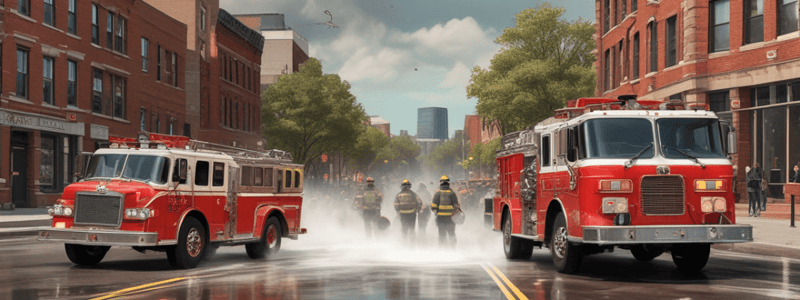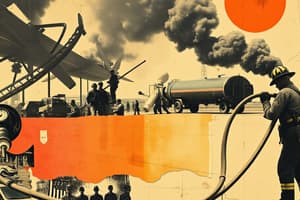Podcast
Questions and Answers
What is the main purpose of the hydrant kit bag in Toronto Fire Services?
What is the main purpose of the hydrant kit bag in Toronto Fire Services?
- To store tools for maintenance
- To store emergency oxygen supplies
- To carry spare parts for the apparatus
- To make securing a water supply more efficient (correct)
In a forward lay, what occurs after the apparatus stops at the hydrant location?
In a forward lay, what occurs after the apparatus stops at the hydrant location?
- The firefighter connects the hose to the apparatus
- The firefighter exits the apparatus and retrieves the hydrant kit bag (correct)
- The apparatus proceeds to the incident
- The firefighter proceeds to the incident
What is a disadvantage of the forward lay method?
What is a disadvantage of the forward lay method?
- The firefighter is left alone at the hydrant
- The apparatus must stop at the incident
- Flow rates decrease
- Friction loss becomes an issue in the supply line as flow rates increase (correct)
What is the size of the gate valves in the hydrant kit bag?
What is the size of the gate valves in the hydrant kit bag?
Where is the hydrant kit bag typically stored on the apparatus?
Where is the hydrant kit bag typically stored on the apparatus?
What is used to connect the 100mm hose to the hydrant?
What is used to connect the 100mm hose to the hydrant?
What is the primary purpose of the J-Wrap method in securing the hose to the hydrant?
What is the primary purpose of the J-Wrap method in securing the hose to the hydrant?
What is the benefit of using the reverse lay method?
What is the benefit of using the reverse lay method?
What is the primary scenario where a split hose lay is commonly used?
What is the primary scenario where a split hose lay is commonly used?
What is the signal given to the apparatus driver to indicate that the hose is laid out?
What is the signal given to the apparatus driver to indicate that the hose is laid out?
What is the purpose of the firefighter following behind the apparatus in a split hose lay?
What is the purpose of the firefighter following behind the apparatus in a split hose lay?
What happens to the apparatus after the firefighter at the hydrant begins connecting to the hydrant and charging the supply line?
What happens to the apparatus after the firefighter at the hydrant begins connecting to the hydrant and charging the supply line?
What is the benefit of using a reverse lay in terms of connecting multiple supply lines?
What is the benefit of using a reverse lay in terms of connecting multiple supply lines?
What is the distance the hose is laid out in front of the hydrant?
What is the distance the hose is laid out in front of the hydrant?
What is the purpose of the firefighter moving the supply hose after the line is charged?
What is the purpose of the firefighter moving the supply hose after the line is charged?
How much supply hose is removed by the firefighter in a split hose lay?
How much supply hose is removed by the firefighter in a split hose lay?
Flashcards are hidden until you start studying
Study Notes
Hydrant Kit Bag
- The hydrant kit bag is stored in the right rear compartment of the apparatus.
- The kit bag contains:
- 2 x 65mm gate valves with 100mm Storz adapters
- 1 x hydrant wrench
- 2 x spanner wrenches
- 1 x dead blow hammer
Forward Lay
- In a forward hose lay, hose is deployed from the water source to the incident.
- The firefighter connects to the hydrant while the apparatus proceeds to the fire.
- Disadvantages of forward lay:
- Friction loss becomes an issue in the supply line as flow rates increase.
- Steps for forward lay:
- Apparatus stops at the hydrant, firefighter exits, and retrieves the hydrant kit bag.
- Firefighter lays the hose down and folds it back onto itself, making a bight.
- The hose is secured against the barrel of the hydrant with the toe of the firefighter's boot.
- Signal is given to the apparatus driver to 'LAY HOSE'.
Reverse Lay
- In a reverse hose lay, hose is deployed from the incident scene to the water source.
- Advantages of reverse lay:
- Decreases friction loss from the hydrant to the apparatus.
- Easier to connect multiple supply lines from the hydrant to the apparatus intakes.
- Steps for reverse lay:
- Firefighters remove tools and equipment from the apparatus before it proceeds to the water source.
- Pump operator begins supplying attack lines, then secures their own water source.
Split Lay
- In a split hose lay, supply hose is dropped by an apparatus and connected to by another apparatus.
- Commonly used in:
- Dead-end streets
- Industrial/commercial complexes with private water supply
- Long access roads/driveways
- Steps for split lay:
- Apparatus stops at a designated location, firefighter exits, and removes 15m of 100mm supply hose.
- Second arriving apparatus arrives, firefighters exit, and connect to the dropped supply hose.
- Firefighter connects the 100mm hose from their apparatus to the dropped supply line.
- Pump operator secures the water source and coordinates relay pump operations.
Studying That Suits You
Use AI to generate personalized quizzes and flashcards to suit your learning preferences.



